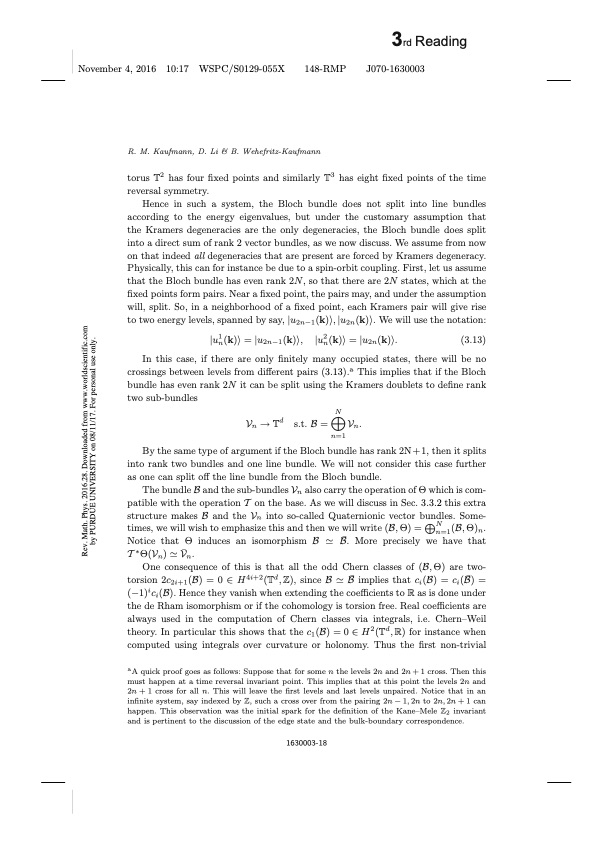
PDF Publication Title:
Text from PDF Page: 018
R. M. Kaufmann, D. Li & B. Wehefritz-Kaufmann torus T2 has four fixed points and similarly T3 has eight fixed points of the time reversal symmetry. Hence in such a system, the Bloch bundle does not split into line bundles according to the energy eigenvalues, but under the customary assumption that the Kramers degeneracies are the only degeneracies, the Bloch bundle does split into a direct sum of rank 2 vector bundles, as we now discuss. We assume from now on that indeed all degeneracies that are present are forced by Kramers degeneracy. Physically, this can for instance be due to a spin-orbit coupling. First, let us assume that the Bloch bundle has even rank 2N, so that there are 2N states, which at the fixed points form pairs. Near a fixed point, the pairs may, and under the assumption will, split. So, in a neighborhood of a fixed point, each Kramers pair will give rise to two energy levels, spanned by say, |u2n−1(k)⟩,|u2n(k)⟩. We will use the notation: |u1n(k)⟩ = |u2n−1(k)⟩, |u2n(k)⟩ = |u2n(k)⟩. (3.13) In this case, if there are only finitely many occupied states, there will be no crossings between levels from different pairs (3.13).a This implies that if the Bloch bundle has even rank 2N it can be split using the Kramers doublets to define rank two sub-bundles N n=1 By the same type of argument if the Bloch bundle has rank 2N+1, then it splits into rank two bundles and one line bundle. We will not consider this case further as one can split off the line bundle from the Bloch bundle. The bundle B and the sub-bundles Vn also carry the operation of Θ which is com- patible with the operation T on the base. As we will discuss in Sec. 3.3.2 this extra structure makes B and the Vn into so-called Quaternionic vector bundles. Some- times, we will wish to emphasize this and then we will write (B, Θ) = Nn=1(B, Θ)n. Notice that Θ induces an isomorphism B ≃ B ̄. More precisely we have that T ∗Θ(Vn) ≃ V ̄n. One consequence of this is that all the odd Chern classes of (B,Θ) are two- torsion 2c2i+1(B) = 0 ∈ H4i+2(Td,Z), since B ≃ B ̄ implies that ci(B) = ci(B ̄) = (−1)ici(B). Hence they vanish when extending the coefficients to R as is done under the de Rham isomorphism or if the cohomology is torsion free. Real coefficients are always used in the computation of Chern classes via integrals, i.e. Chern–Weil theory. In particular this shows that the c1(B) = 0 ∈ H2(Td,R) for instance when computed using integrals over curvature or holonomy. Thus the first non-trivial aA quick proof goes as follows: Suppose that for some n the levels 2n and 2n+1 cross. Then this must happen at a time reversal invariant point. This implies that at this point the levels 2n and 2n + 1 cross for all n. This will leave the first levels and last levels unpaired. Notice that in an infinite system, say indexed by Z, such a cross over from the pairing 2n − 1, 2n to 2n, 2n + 1 can happen. This observation was the initial spark for the definition of the Kane–Mele Z2 invariant and is pertinent to the discussion of the edge state and the bulk-boundary correspondence. Vn → Td s.t. B = Vn. 1630003-18 Rev. Math. Phys. 2016.28. Downloaded from www.worldscientific.com by PURDUE UNIVERSITY on 08/11/17. For personal use only.PDF Image | Notes on topological insulators

PDF Search Title:
Notes on topological insulatorsOriginal File Name Searched:
RMP.pdfDIY PDF Search: Google It | Yahoo | Bing
Sulfur Deposition on Carbon Nanofibers using Supercritical CO2 Sulfur Deposition on Carbon Nanofibers using Supercritical CO2. Gamma sulfur also known as mother of pearl sulfur and nacreous sulfur... More Info
CO2 Organic Rankine Cycle Experimenter Platform The supercritical CO2 phase change system is both a heat pump and organic rankine cycle which can be used for those purposes and as a supercritical extractor for advanced subcritical and supercritical extraction technology. Uses include producing nanoparticles, precious metal CO2 extraction, lithium battery recycling, and other applications... More Info
| CONTACT TEL: 608-238-6001 Email: greg@infinityturbine.com | RSS | AMP |